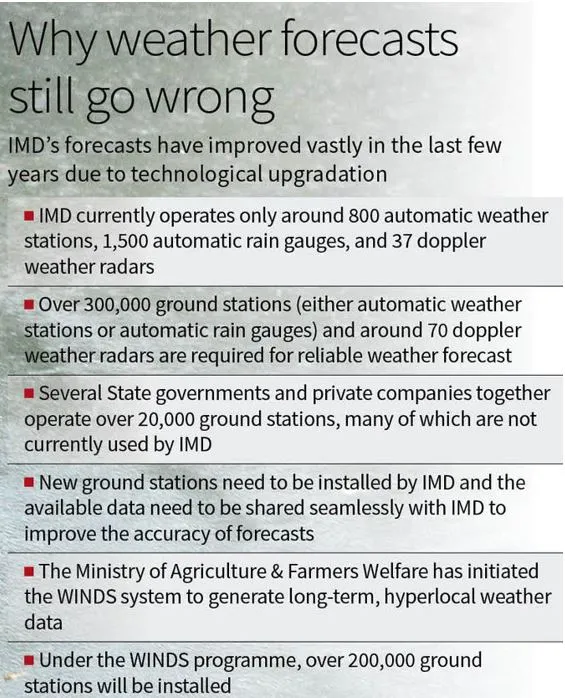

12th September 2024 (10 Topics)
Context
The Union Cabinet has approved 'Mission Mausam' with a budget of Rs 2,000 crore over two years. This initiative aims to significantly enhance India's capabilities in weather and climate-related science and services.
About Mission Mausam
- Mission Mausam is envisaged to be a multi-faceted and transformative initiative to tremendously boost India's weather and climate-related science, research, and services.
- Objective: To create a more weather-ready and climate-smart Bharat.
- It will help to better equip stakeholders, including citizens and last-mile users, in tackling extreme weather events and the impacts of climate change.
- Critical elements of Mission Mausam will include
- deployment of next-generation radars and satellite systems with advanced sensors and high-performance supercomputers
- development of improved Earth system models and a GIS-based automated Decision Support System for real-time data dissemination
- Mission Mausam will focus on advancing research and development in atmospheric sciences, improving weather surveillance, forecasting, and management.
- The mission will leverage advanced technologies like artificial intelligence, machine learning, and high-performance computing.
- The mission will benefit multiple sectors including agriculture, disaster management, aviation, and health. It aims to improve data-driven decision-making across urban planning, transport, and environmental monitoring.
- Institutional Role: Implementation will be led by the India Meteorological Department, Indian Institute of Tropical Meteorology, and the National Centre for Medium-Range Weather Forecasting, with support from other Ministry of Earth Sciences institutions and national and international collaborators.
- Implementing Agency: It will be implemented by three key institutions under the Ministry of Earth Sciences (MoES):
- India Meteorological Department
- Indian Institute of Tropical Meteorology
- National Centre for Medium-Range Weather Forecasting
- These will be supported by other MoES bodies, such as the Indian National Centre for Ocean Information Services, the National Centre for Polar and Ocean Research and the National Institute of Ocean Technology.
Need for 'Mission Mausam' in India:
Predicting weather events with a high level of accuracy has become increasingly important in India, one of the most vulnerable nations to climate change. It allows the country to better prepare - from issuing early heat and rain warnings to coordinating power supplies to guiding farmers on how to protect their crops.
- Vulnerability: Almost 58.6 percent of the landmass is prone to earthquakes of moderate to very high intensity; over 40 million hectares (12 per cent of land) are prone to floods and river erosion; of the 7,516 km long coastline, close to 5,700 km is prone to cyclones and tsunamis; 68 per cent of the cultivable area is vulnerable to drought and hilly areas are at risk from landslides and avalanches.
- Increased Frequency of Extreme Weather Events: Extreme weather events like heatwaves and cloudbursts, which were rare in the past, are now happening throughout the year, highlighting the need for accurate forecasts.
- Climate-Induced Vagaries: Climate change has led to severe and unexpected weather conditions such as Wayanad landslide and lake bursts in Sikkim, Uttarakhand, underscoring the necessity for improved weather prediction.
- Need for Hyper-Local Weather Data: There is a growing demand for precise weather forecasts at very local levels for specific needs like farming and daily activities.
- Increased Intensity of Rainfall: The frequency and intensity of heavy, localized rainfall have surged, making accurate weather predictions crucial to manage water resources and prevent flooding.
- For accurate forecasting: In tropical countries like India, weather variability is inherently higher. IMD’s forecasts have improved vastly in the last few years as it has upgraded to technologies similar to the ones used by the U.S., the U.K. and Japan. Yet, there are still many days and geographies for which Indian forecasts go wrong, especially during winter and summer monsoon.

Challenges in weather forecasting
- Lack of weather monitoring ground stations: Currently, IMD operates around 800 automatic weather stations (AWS), 1,500 automatic rain gauges (ARG) and 37 doppler weather radars (DWR). This is against the total requirements of more than 3,00,000 ground stations (AWS/ARG) and around 70 DWRs.
- Dependency on global system: Currently, most of the prediction software used in forecasting are based on the global forecasting system and weather research and forecasting models, both of which are not the most modern.
Fact Box: Recent Initiatives for Weather Forecasting
|
More Articles


